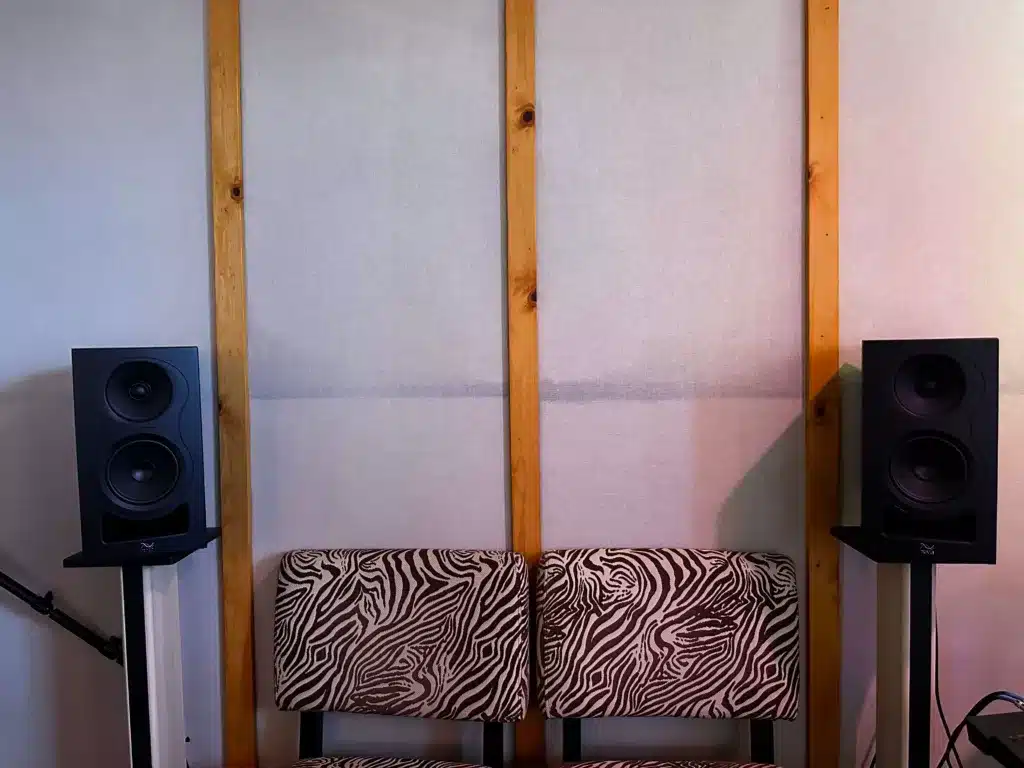Introduction:
In today’s music industry, having a personal space where you can create, experiment, and produce music is not just a luxury; it’s a necessity. A home studio offers unparalleled convenience and control, allowing artists and engineers to work at their own pace and in their own space. In this article, I’ll guide you through the key elements you need to consider when setting up your own home studio, drawing from my extensive experience in the field.
Quality Acoustic Treatment
The foundation of any great home studio is its acoustic treatment. Room acoustics play a crucial role in how sound is perceived and recorded. Poorly treated rooms can lead to inaccurate sound reproduction, making mixing and mastering a challenge. To combat this, incorporating bass traps, acoustic panels, and diffusers is essential.
Bass traps are designed to absorb low-frequency sounds and are typically placed in room corners where bass tends to accumulate. Acoustic panels help in absorbing mid to high-frequency sounds and should be strategically placed on walls and ceilings. Conversely, Diffusers are used to scatter sound waves, reducing standing waves and flutter echoes, thereby creating a more balanced listening environment.
When installing these treatments, focus on key areas like the points of first reflection, corners, and areas behind your monitors and mixing position. Remember, the goal is to achieve a well-balanced room, not to completely deaden it.
Reliable Audio Interface
The audio interface is indeed the heart of your home studio, serving as the crucial link between your microphones, instruments, and computer. A quality interface should not only provide pristine audio quality but also have sufficient inputs and outputs to match your recording needs.
The Universal Audio Apollo Twin is an outstanding choice, especially for its high-quality preamps, excellent AD/DA converters, and the UAD-2 processing power. This interface is particularly beneficial for those who require top-notch sound quality and onboard DSP processing in a compact form factor.
In addition to the Apollo Twin, here are a few other options that are well-suited for home studios:
-
Focusrite Scarlett Series: The Scarlett range, particularly the Scarlett 2i2 or 4i4 models, is a great choice for beginners and intermediate users. These interfaces are known for their reliable performance, high-quality preamps, and ease of use. They are also quite affordable, making them a popular choice for home studios on a budget.
-
Steinberg UR Series: The UR22C or UR44C are excellent choices for those looking for a balance between quality and price. These interfaces offer solid build quality, great sound, and compatibility with a wide range of software. They also come with DSP features, providing latency-free monitoring with effects.
-
MOTU M2 and M4: For those who need more inputs and outputs without compromising on quality, the MOTU M2 and M4 interfaces offer exceptional audio quality, ultra-low latency, and a robust set of features. They are also known for their detailed metering, which is a big plus during recording sessions.
-
PreSonus Studio Series: The PreSonus Studio 24c and 26c are other noteworthy contenders. They are recognized for their high-quality converters and XMAX preamps. Additionally, they often come bundled with PreSonus’ own DAW software, Studio One, which is a great value addition for those starting out.
-
RME Babyface Pro: For a more high-end option, the RME Babyface Pro is renowned for its top-tier sound quality, rock-solid drivers, and professional features. It’s a bit pricier but a worthy investment for those looking for a long-term, professional-grade interface.
Professional Studio Monitors

Kali Audio Speakers sit in my studio by the back wall. Great for referencing mixes on.
Studio monitors are a fundamental element in a home studio, offering an uncolored and accurate representation of sound that’s essential for critical listening and precise mixing. Unlike consumer speakers, which often enhance certain frequencies to appeal to a general audience, studio monitors like Kali Audio’s IN-Series provide a flat frequency response, essential for identifying nuances in a mix.
However, it’s important to remember that no studio monitor, regardless of its quality, can completely compensate for room acoustics and personal listening preferences. Even monitors with exceptional design, like the Kali Audio IN-Series, have their limitations and may perform differently in various environments.
The IN-Series, including models such as the IN-8, are praised for their coaxial design, which aims to provide consistent sound across different listening positions by reducing off-axis lobing. This design can indeed offer more accurate imaging, crucial for detailed mixing work. But it’s also worth noting that this architecture might not suit all types of audio work or personal preferences. Some users might find the sound too focused, or they may prefer the dispersion characteristics of traditional designs for a wider sweet spot.
While the powerful woofers and optimized midrange drivers of the IN-Series deliver a balanced output across the frequency spectrum, this doesn’t guarantee a perfect translation of mixes to other listening environments. Variables such as room size, shape, and furnishing, as well as the listener’s position relative to the monitors, significantly affect the perceived sound. This means that even with high-quality monitors like the IN-Series, additional room treatment and careful placement are necessary for optimal performance.
In conclusion, while studio monitors are indispensable in a home studio for achieving professional sound quality, their effectiveness is influenced by a variety of factors. Products like Kali Audio’s IN-Series offer innovative features that can enhance mixing and listening experiences, but they are part of a broader ecosystem that includes room acoustics, monitor placement, and personal preference. It’s crucial for users to consider these aspects when setting up their home studio to ensure they get the most out of their equipment.
Versatile Microphone Selection
Your microphone collection is a pivotal aspect of your studio setup, with each type serving distinct recording purposes. Understanding the characteristics and applications of different microphones can significantly enhance your recording quality.
-
Condenser Microphones: Known for their sensitivity and wide frequency response, condenser microphones are ideal for capturing vocal subtleties and intricate high-frequency content. They require phantom power, usually supplied by your audio interface or mixing console. A great starting point is the Audio-Technica AT2020, a versatile and affordable option known for its clarity and detail. For those looking for a step up, the Rode NT1-A offers a beautifully balanced sound with low noise, making it a favorite for vocal recordings.
-
Dynamic Microphones: Renowned for their durability and ability to handle high sound pressure levels, dynamic microphones are the workhorses of the studio. They excel in capturing loud sources like drums and guitar amplifiers. The Shure SM57 is an industry standard, known for its reliability and ability to capture a wide variety of instruments with fidelity. Another excellent choice is the Sennheiser MD 421, which is particularly good for toms and guitar cabinets due to its full-bodied sound and excellent off-axis rejection.
-
Ribbon Microphones: Ribbon mics are prized for their natural, warm sound characteristics. They are typically more delicate and expensive but are unmatched in capturing the nuances of room ambience and string instruments. The Royer R-121 is a popular choice in professional studios, known for its smooth response and classic ribbon microphone sound. For a more budget-friendly option, the sE Electronics X1R offers a taste of ribbon microphone quality without breaking the bank.
When starting out, it’s also crucial to consider your recording environment and the genres you’ll be working with. For instance, if you’re recording a lot of acoustic instruments or vocals, a good quality condenser microphone should be your priority. On the other hand, if you’re recording louder sources like electric guitars or drums, dynamic microphones will serve you well.
I highly recommend using resources like Audio Test Kitchen to compare and listen to different microphones. This platform allows you to hear how various microphones respond to the same source material, providing a practical way to understand their tonal differences and make an informed decision.
Remember, the right microphone can elevate your recordings significantly, so consider your choices as an investment in your studio’s future.
High-Quality Cables and Accessories
Often overlooked, cables and accessories play a crucial role in the signal chain. Investing in high-quality XLR, TRS, and MIDI cables can significantly improve the fidelity of your recordings. Additionally, accessories like microphone stands, pop filters, and headphone amplifiers are essential for a functional and efficient recording environment.
Conclusion:
Building a home studio is a journey of both technical and creative exploration. The components I’ve outlined – acoustic treatment, a reliable audio interface, professional studio monitors, a versatile microphone selection, and high-quality cables and accessories – form the backbone of a functional and inspiring home studio. As you embark on this journey, remember that each choice you make should serve your unique creative vision. I invite you to share your home studio experiences or questions in the comments below. Let’s build and learn together in this ever-evolving world of music production.
If you’re looking for professional mixing or mastering services, make sure to reach out to me. You’ll also find presets and courses tailored to enhance your music production journey. Stay tuned for more insights and discussions soon!






